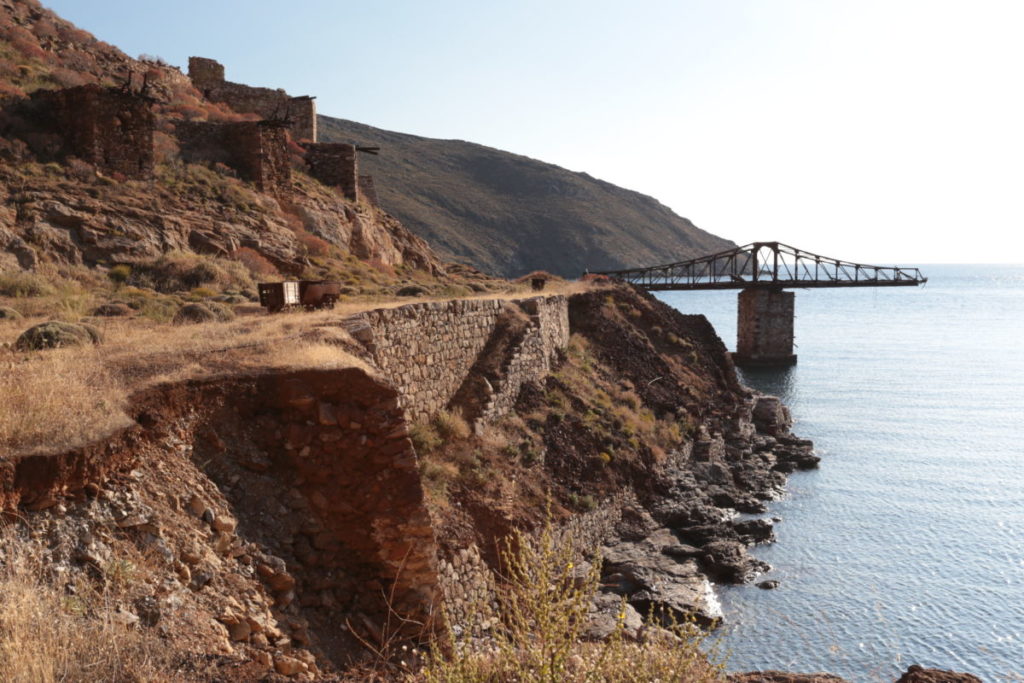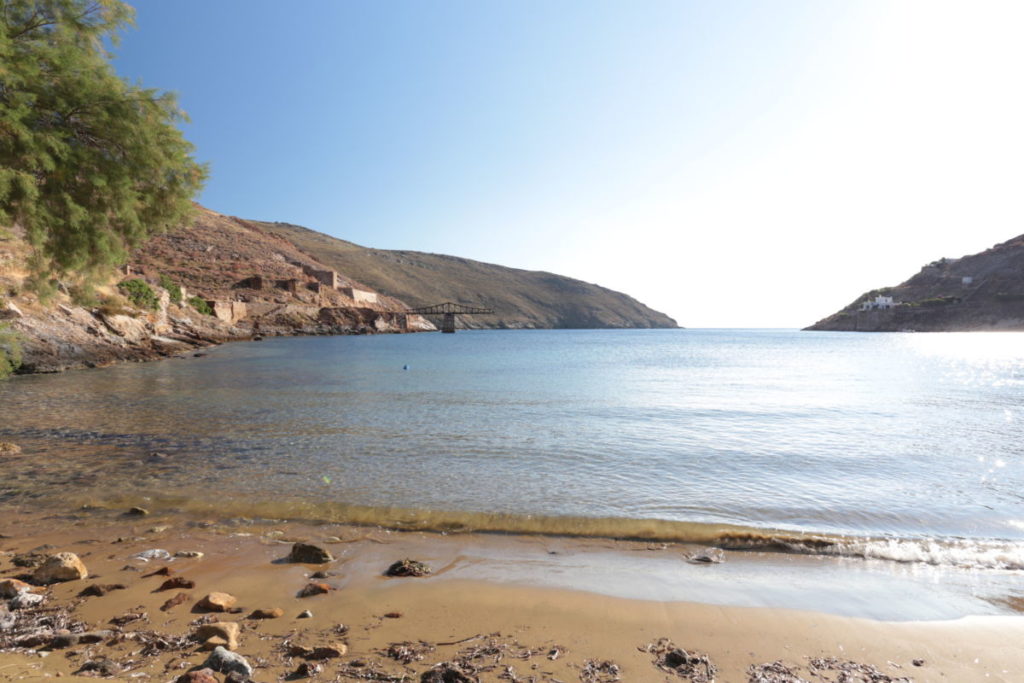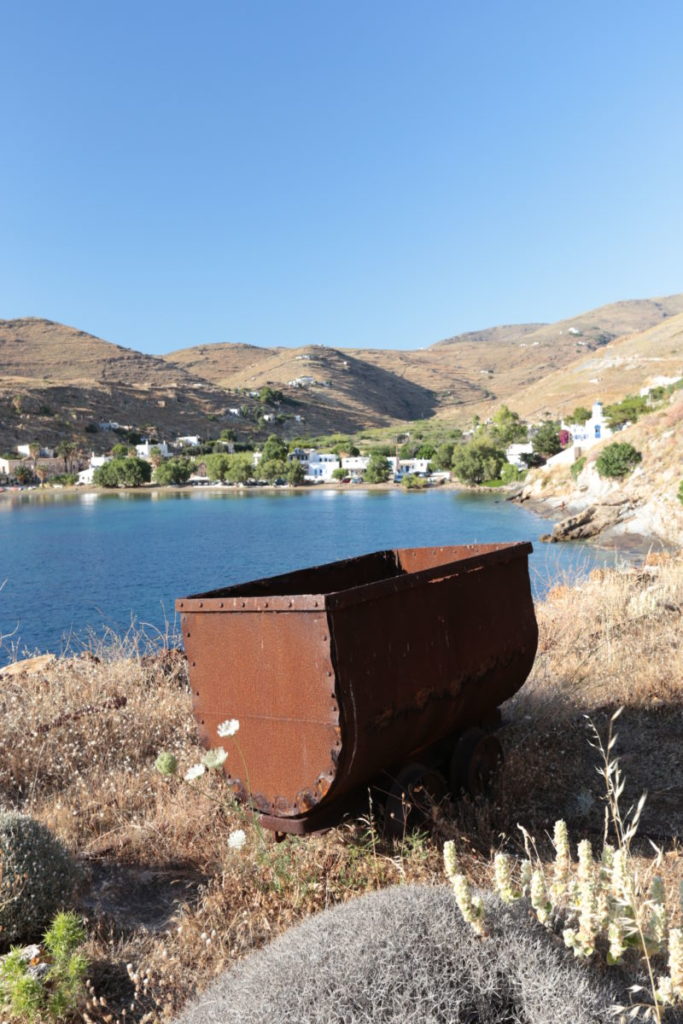Megalo Livadi Serifos

Megalo Livadi Serifos
Megalo Livadi Serifos is a remote village on the south western coast of Serifos, a drive of about 30 minutes from the Livadi port area. It’s quite a spectacular drive as you negotiate the twist and turns through the mountainous terrain but there’s not much to see on the way.
One good stop is the lovely Vagia Beach where you will find Coco-Mat Eco Residences Serifos. Its a really nice beach but careful with kids – its rather steep in the water. A snack bar operates during tourist season.
When you get to Megalo Livadi Serifos (or Mega Livadi Serifos as its also known) you’ll find a typical quiet Greek bay setting. But as you start to explore, you’ll find that this village has some significant history with remnants of the mining operations still very much visible around the village.

Megalo Livadi Serifos – the village
The bay beach is a typical shallow inlet beach – it’s probably not one you would drive 30 minutes to go to on its own but its not a bad place to stop and rest. There are a couple of tavernas (Kyklopas maybe the best known) that can serve you refreshments under the shady trees at the sea’s edge. Close by you can see the remains of the rather grand mining offices which give a hint of the financial returns in their day.
Otherwise there is not much more to the village itself – an outpost with a chequered past.


Megalo Livadi Serifos – mining history
Early Mining on Serifos
Mining on Serifos island dates back over 3000 years to the ancient Greeks. The island’s rich mineral resources of iron ore, lignite, emery and copper were highly valued commodities. Ancient miners extracted ore through tunnels and primitive mining techniques.
When the Greeks were under Roman rule, mining operations expanded, and Serifos became one of the empire’s key mining centers. Ore was extracted from underground galleries on a large scale to fuel iron production across Roman territories.
After the fall of Rome, mining declined in the following centuries under Byzantine rule. But Serifos’ vast iron ore reserves would not remain untapped for long.
The 19th Century Mining Boom
In the early 19th century, industrialization and new mining methods triggered a mining boom on Serifos. Iron mining operations grew under Greek independence, and major mining companies were established on the island.
Megalo Livadi became a hub for mining because of its large, high-quality ore deposits right by the coast. Its harbour facilitated the transport of iron ore to mainland Greece and abroad. In the village, migrant miners from other islands eg Amorgos and mine workers settled near the excavation sites and processing plants.
By the late 1800s, Serifos was producing over 250,000 tons of iron annually and had over 600 mine sites. Large mining facilities operated by European venture capitalists sprang up around Mega Livadi to process the prodigious amounts of ore.
Unrest and the 1916 Miners’ Strike
Though the mining industry generated great wealth for the companies, workers faced dire conditions. Hours were long, safety was dismal, and miners toiled in a toxic environment. Mega Livadi’s workers were exposed to hazards like cave-ins, explosions and toxic gases.
As a result, a general strike began on 7th August 1916 when the miners refused to load the ship “Manousi” from Andros Island. The government in Athens had to send help in the form of a 30-man contingent of the Hellenic Gendarmerie from nearby Kea Island to quell the workers revolt and they arrived on 21st August. A group of around 400 miners had gathered by a loading bridge at the docks in Megalo Livadi as well as about 1,500 women and children.
What followed was a confused and sometimes violent confrontation in several areas of the villages with a few deaths on both sides. One real benefit from the action (as well as similar protests elsewhere in Greece) was that the idea of an ‘8 hour shift’ as a limit to the working day became law, replacing the expectation of dawn till dusk working at Megalo Livadi.
This courageous stand by Megalo Livadi’s miners against the unethical industry practices of the time is still commemorated proudly on the island today.
Decline of Mining in the 20th Century
By the mid-1900s, Serifos’ iron ore reserves were depleting rapidly after decades of intensive mining. As mines became less productive and costly , companies halted excavations. The mining industry declined through the 20th century, finally ceasing operations in the 1980s.